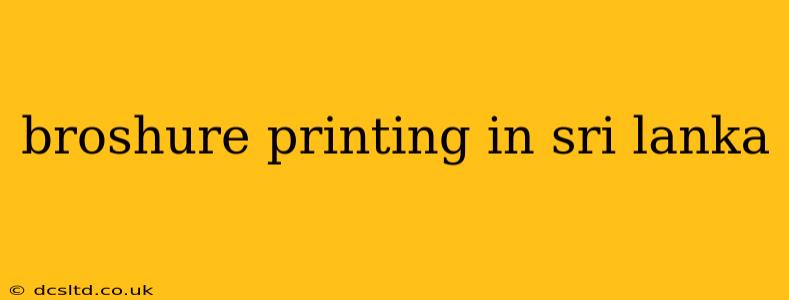Sri Lanka's vibrant economy and diverse business landscape demand high-quality marketing materials. Brochures, with their ability to convey information concisely and attractively, remain a cornerstone of effective marketing strategies. This guide explores the world of brochure printing in Sri Lanka, covering everything from choosing the right printer to understanding different printing techniques and paper options.
What are the different types of brochures available in Sri Lanka?
Sri Lankan printers offer a wide variety of brochure types to suit different needs and budgets. These include:
- Bi-fold brochures: Simple and cost-effective, these brochures fold in half to create a four-panel design. Ideal for concise messaging and product showcases.
- Tri-fold brochures: Folding into thirds, these offer more space for detailed information and can incorporate compelling visuals. Popular for showcasing services or detailed product information.
- Z-fold brochures: These create a more dynamic and eye-catching presentation with a zigzag fold. Often used for complex information or visually rich content.
- Gatefold brochures: A sophisticated option creating a dramatic unfolding effect, often reserved for premium products or high-end marketing campaigns.
- Roll-fold brochures: These brochures fold in a parallel fashion, ideal for showcasing a sequence of images or information.
What are the different printing methods for brochures in Sri Lanka?
The printing method you choose significantly impacts the final look and cost of your brochures. Common methods include:
- Offset printing: Suitable for large print runs, offset printing offers high-quality results at a lower cost per unit. This is the preferred choice for mass marketing campaigns.
- Digital printing: Ideal for smaller print runs, digital printing provides fast turnaround times and allows for personalized brochures. Great for short-term campaigns or targeted marketing.
- Screen printing: Best suited for specialized projects involving vibrant colors and unique textures on various materials, screen printing adds a high-end artistic touch to your brochure.
What type of paper is best for brochure printing in Sri Lanka?
The paper you select affects the feel, durability, and overall impact of your brochure. Consider these options:
- Glossy paper: Provides vibrant colors and a sharp, professional look. Ideal for showcasing high-quality images.
- Matte paper: Offers a more subtle, sophisticated finish, reducing glare and making the text easier to read.
- Uncoated paper: Provides a natural, textured feel, lending a rustic or environmentally friendly aesthetic.
- Recycled paper: An eco-conscious option that aligns with sustainability initiatives.
Where can I find brochure printing services in Sri Lanka?
Numerous printing companies operate across Sri Lanka, offering a range of services and pricing. It's advisable to compare quotes from several printers before making a decision. Look for companies with experience in brochure printing and a strong reputation for quality. Online directories and business listings can assist your search.
What is the average cost of brochure printing in Sri Lanka?
The cost of brochure printing varies significantly depending on factors like the quantity printed, the type of paper, the printing method, and the finishing options (lamination, binding, etc.). It's best to obtain quotes from several printers to compare prices accurately.
How long does it take to print brochures in Sri Lanka?
Turnaround times depend on the printing method and the size of the order. Digital printing offers faster turnaround times compared to offset printing, which is suitable for larger orders but requires more time. Always clarify the timeline with your chosen printer.
What finishing options are available for brochures in Sri Lanka?
Several finishing options can enhance the look and feel of your brochures:
- Lamination: Provides protection against damage and enhances the overall look. Glossy lamination adds shine, while matte lamination offers a more subtle finish.
- Spot UV: Adds a glossy finish to specific areas of the brochure, creating a dramatic effect.
- Embossing/Debossing: Creates a raised or indented texture on the paper, adding a premium feel.
- Die-cutting: Allows for custom shapes and sizes, making the brochure more unique and memorable.
By carefully considering these factors, you can ensure your brochures effectively communicate your message and make a lasting impression on your target audience in the competitive Sri Lankan market. Remember to always request samples and clearly communicate your specific needs to your chosen printer to ensure optimal results.
